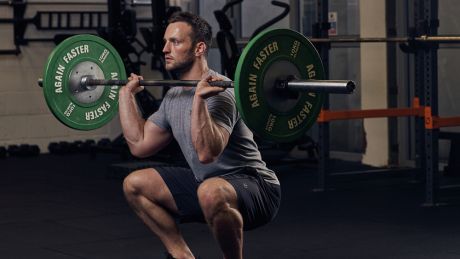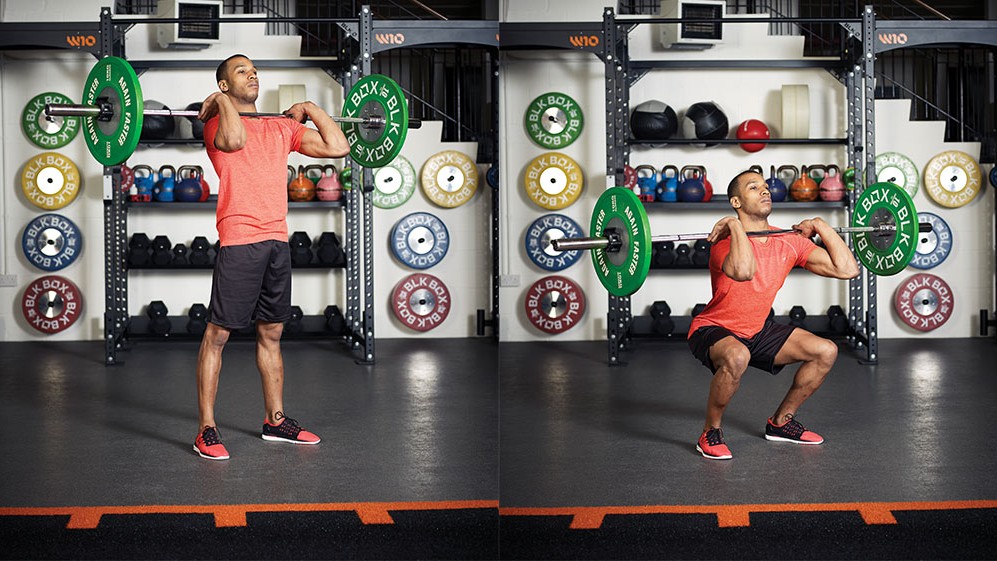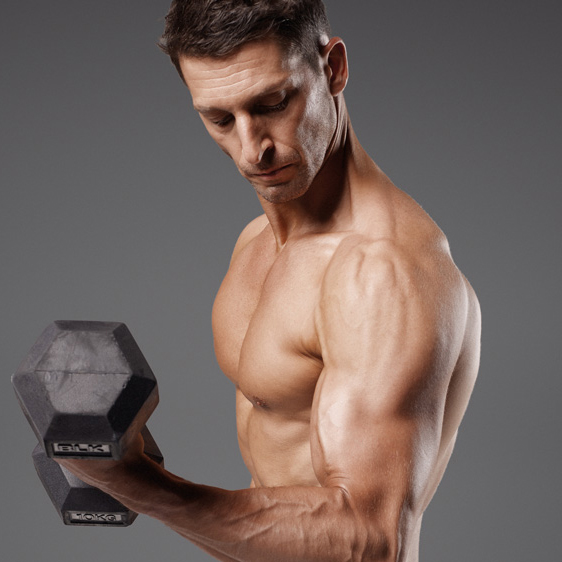Front Squat: The Best Exercise You Aren’t Doing
Back squats might let you lift heavier, but the front squat will force your body to grow. Here’s how to do it properly

The back squat is the classic lower-body lift. It packs muscle on your glutes, quads and hamstrings, as well as recruiting your abs and lower back which must work hard to stabilise your torso as you lift and lower the bar. It’s also an effective strength-building move, which is why it’s so popular with elite athletes from 100m sprinters to UFC fighters to American footballers to swimmers.
But there’s another move you should add to your leg-building workouts if you’re serious about adding muscular size and strength to your lower body: the front squat.
It’s an often-neglected lift but one that deserves your attention. While similar the back squat, it has one key difference: you hold the bar across the front of your shoulders, at the top of your chest, rather than behind your neck.
This significant adjustment forces your quads, the muscle group on the front of your thighs, to manage and move more of the load, as well as making your core muscles work even harder to keep your torso upright and your upper body balanced.
And there’s a bonus, too. Unlike the back squat, where it’s common for your form to suffer towards the end of each set, the position you’re in for the front squat forces you to stay upright and maintain the correct form, which means you can squat far more safely. Here’s everything you need to know.
How To Do The Front Squat

The Set-up
Start with the bar secure in the squat rack, level with the middle of your chest. Hold the bar with hands just wider than shoulder-width apart. Step in close to the bar and lower into a quarter squat so the bar is level and touching the top of your chest and front of your shoulders. Without letting go of the bar, bring your elbows forwards and up as high as you can manage. Focus on keeping your elbows as high as possible throughout the squat – this will keep your body upright and the bar secure in the crook of your hands and resting against your chest and shoulders. Drive up to take the bar out of the rack.
The Move
Take one step backwards. Position your feet shoulder-width apart, with your toes pointing very slightly diagonally away from each other. Brace yourself, take a deep breath in to fill your chest and keep your torso strong, then bend your legs to lower into a squat. Keep your knees wide apart and heels down. Lower until your legs are at least parallel with the floor, then drive back up to stand. That’s perfect form. If you’re struggling, here are some ways to improve.
Sign up for workout ideas, training advice, reviews of the latest gear and more.
Front Squat Form Tips
Hand Position
The perfect form for the front squat can be difficult due to limited flexibility of the wrists and forearms if you're not used to it. If that’s you, start by warming your wrists up. Interlock your fingers and rotate your wrists in both directions for a couple of minutes. Still an issue? A solution is to get into the position where you're about to lift the bar out of the rack, but cross your arms and hold the bar against your shoulders. Keeping your shoulders high is still a priority here. You’ll probably not be able to lift as much weight so knock the weight plates down until you're comfortable.
Elbows
As soon as you let your elbows drop, the weight will tip forwards, pushing you off-balance and signalling the end of your set. Fix this by focusing on pushing your elbows towards the ceiling throughout the move. Also, try bringing your hands closer together or further apart to find a position that lets you keep your elbows high.
Front Squat Variations
Elevated heels front squat
In all squats, ankle mobility and calf flexibility can be an issue. While you work on improving those departments, you can still front squat by elevating your heels on small weight plates for this move. This can also allow you to go deeper and put more emphasis on your quads for greater development.
Goblet squat
If you’re not sure about taking on a loaded barbell in a front squat, you can build up to it by using a kettlebell or dumbbell first. Hold the weight against your chest with your arms bent so your hands are above your elbows (as if holding a goblet in two hands). Drop into a squat until your elbows touch the inside of your knees, then drive back up to a standing position. This exercise will get you used to holding a weight in front of your body while squatting, and is a great leg-strengthener in its own right.
Offset kettlebell front squat
This exercise acts as a progression from the goblet squat as you build up to the full front squat, and is a great way to work out your core in general. The idea is to place more load on one side of the body, so your core has to resist the urge to turn to that side as you squat, which enlists different muscles that those involved in a straight up-and-down squat. You can do the offset squat with either a kettlebell on one shoulder or two kettlebells of different weights. Hold the kettlebell in the rack position against your shoulder and drop into a squat until your elbow passes the inside of your thigh, then push back up, all the while ensuring you resist any rotation in your torso.
Band-resisted front squat
If you decide lifting the weight on the bar isn’t enough for you, you can add a resistance band. This doesn’t just increase the overall resistance involved in the lift, but loads that resistance towards the top of the move, since that’s where the tension in the band will be at its greatest. This means there’s no extra load on the bottom part of the exercise, which could be risky given the mobility challenge of the squat, but it does increase your power and force you to drive all the way up as you stand to counter the band’s growing resistance.
To perform this variation, attach the resistance band to a racked bar, keeping the two loops on the bar slightly wider than shoulder-width apart, then stand on the resistance band so it’s taut. Then perform your front squat as normal, being careful not to let the extra resistance in the second half of the exercise throw off your form.

Joe Warner is a highly experienced journalist and editor who began working in fitness media in 2008. He has featured on the cover of Men’s Fitness UK twice and has co-authored Amazon best-sellers including 12-Week Body Plan. He was the editor of Men’s Fitness UK magazine between 2016 and 2019, when that title shared a website with Coach.
- Nick Harris-FrySenior writer
